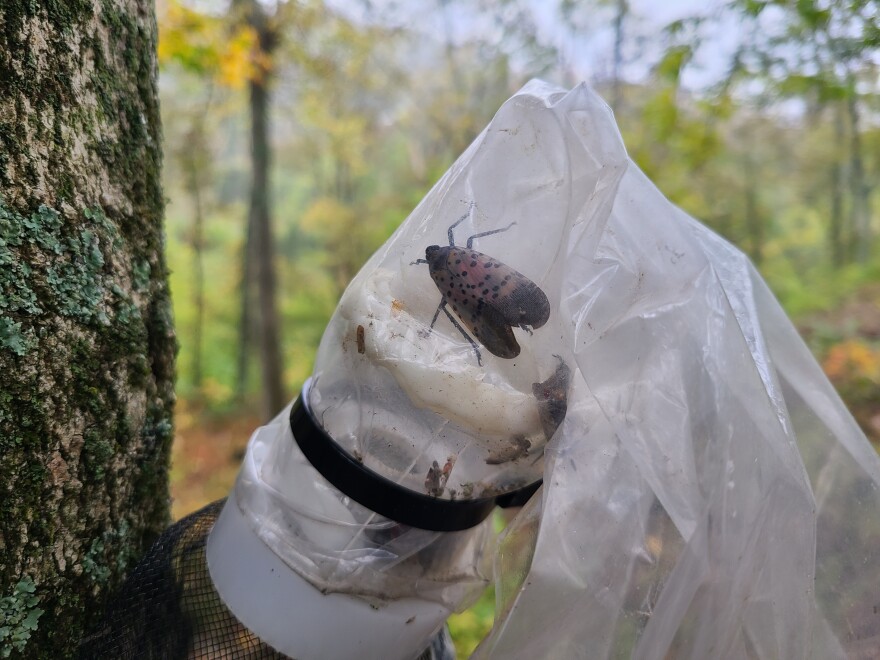Homemade-looking traps recently showed up in Mt. Airy Forest; they're there to catch the invasive spotted lanternfly.
"We found a (spotted) lanternfly in Mt. Airy in July of this year, and that is significant to us because, although they had been found in Hamilton County already the year before, that was the only sighting that was known to us. So this, to our knowledge, was the second finding of them not right next to where they've been found previously," reports Drew Goebel, a conservation technician with Cincinnati Parks.
Since then, Cincinnati Parks employees have found spotted lanternflies in another part of Mt. Airy Forest and in Parkers Woods in Northside. The invasive pests have also been spotted in other spots around the Tri-State.
The spotted lanternfly is native to Asia. It's been found in at least 14 states, including Ohio and Indiana. It was first spotted in Ohio in 2020 and was designated a destructive plant pest the following year. While they primarily prefer to eat Tree of Heaven, another invasive species, they're a threat to native plants, trees, fruit trees, and grape vineyards — which account for $6 billion in economic activity.
RELATED: Capture, don't kill: Ohio wants this invasive insect intact. For now
Goebel describes the spotted lanternfly as an "evolving situation" in Ohio. He says the park district reached out to the Ohio Department of Agriculture (ODA) for guidance.
"We reached out to them and they came out and put up these traps, which are basically monitoring devices so you can kind of get an idea of, hey, we only see one insect here or two and that's it, just happenstance, or are there actually many, many more," he explains.

So far, Goebel says, the numbers of lanternflies caught in the traps is pretty low. The ODA has also come out and trapped some using what Goebel describes as a backpack vacuum.
However, the insects are in their adult phase now and laying eggs. While the adults won't survive the winter, the eggs will, hatching in the spring and spreading.
RELATED: 7 wild facts about the spotted lanternfly
As for Great Parks of Hamilton County, "Great Parks has not yet received traps from the state, but has been in communication with Cincinnati Parks, the OSU Extension office and the state forester to coordinate future plans," says Jessica Spencer, director of natural resources.
What's the plan?
Environmental agencies are still trying to figure out the best way to fight the spotted lanternfly.
Cincinnati Parks is trying to educate people about what the insect looks like and encouraging people to remove their preferred host tree.
"We're also removing some of the host trees that they really like, specifically the Tree of Heaven (Ailanthus altissima) the invasive tree. That seems to be a preferred species for them to feed on," Goebel says. "They are going to feed on other things, too, but that seems to be what they really like. We already had plans to do that type of work for other conservation goals, so this just aligns with both actually."
You can also help by reporting the insects if you see them. The ODA says you should fill out the Ohio Plant Pest Reporter. The agency notes a clear photo is required for submissions.
"They are approximately one inch, with black bodies and colorful red and gray wings with black markings," according to the ODA. "They will lay eggs (small, gray masses covered by a waxy covering) beginning in October."
You can find pictures of the insect in its various stages of life, as well as more information about them on the ODA's spotted lanternfly website.
Goebel says the preference, for now, is to report the bugs with a picture, rather than killing them.
RELATED: Spotted lanternfly spreading in Ohio: What you should do about it
"You've got to be sure what it is. Don't just go smashing bugs. Please, please, please — bugs are already under so much pressure as well."
The spotted lanternfly doesn't sting or bite, and isn't harmful to humans or pets.



